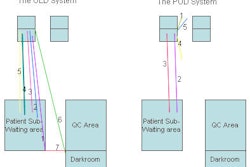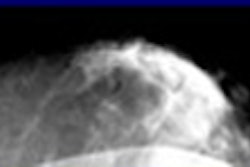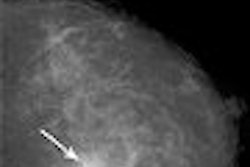Using a wavelet-based compression technique, researchers achieved visually lossless digital mammograms and improved tumor localization, according to a study in the January issue of Radiology.
A goal of the investigation was to address the large datasets produced by digital mammography, which poses a challenge to the transmission, storage, and manipulation of the images, according to lead author Maria Kallergi, Ph.D., and colleagues. Thus far, lossy compression techniques have not proved suitable for clinical mammography.
"The compression algorithm outlined in this article was specifically designed to keep diagnostically important features on mammograms unchanged," wrote Kallergi's group, most of whom are from the H. Lee Moffitt Cancer Center & Research Institute at the University of South Florida in Tampa. Co-author Bradley Lucier, Ph.D., is from Purdue University in West Lafayette, IN (Radiology, January 2006, Vol. 238:1, pp. 62-73).
For this study, 500 single-view abnormal and normal screening mammograms (half in craniocaudal view; half in oblique view) were selected based on lesion size, lesion histology, and density of breast parenchyma.
Films were digitized at 30-µm and 16-bit/pixel resolution on a charged-couple device. The spatial resolution was 90-µm and 12-16-bit/pixel resolution. The images were automatically cropped to remove as much of the background as possible. The compression algorithm was designed by Lucier. The time for compression of a 1410 x 3376-pixel image was 2.24 seconds and the time for decompression was 2.10 seconds.
Co-authors Dr. Jihai Kim, Dr. Marla Hersh, and Dr. Robert Clark, all experienced mammographers, reviewed the original digitized images and the compressed images on one high-resolution monitor. They were asked to identify and report every suspicious breast lesion. A localization response operating characteristic experiment was performed.
According to the results, 60% of the images were compressed at a rate less than 100:1 and greater than 20:1. The mean compression rate was 59:1 for mammograms with negative findings and 53:1 for those with cancerous findings.
The ranges of area under the receiver operating characteristic (ROC) curve were 0.73-0.83 for original mammograms and 0.72-0.86 for reconstructed images. The ranges of the area under the localization response operating characteristic (LROC) curve were 0.39-0.65 for original mammograms and 0.43-0.71 for compressed reconstructed mammograms.
The authors found that with the compressed mammograms the localization accuracy increased by 6% on the average, with performance results favoring interpretation of wavelet-compressed, reconstructed images.
Depending on the finding and the type of disease, there was a 7% increase in correctly localized lesions. However, "readers localized findings more accurately on the compressed mammograms with benign findings than they did on the compressed mammograms with malignant findings," the authors stated. The largest increase in correctly localized lesions was observed in mammograms with benign masses. The smallest increase was in patients with cancerous calcification clusters.
A possible reason for this could be that benign lesions tended to be larger and had more contrast than malignant lesions. However, the removal of random noise by the algorithm did increase the smoothness of the image but did not affect contrast, they explained.
One potential use for this compression algorithm would be to transmit images from rural and underserved communities to major health institutions, where they could be read by breast imaging specialists, according to Lucier (Purdue University News, December 20, 2005).
Moving forward, studies are needed to see if this compression method can be applied to direct digital mammograms, the authors stated.
By Shalmali Pal
AuntMinnie.com staff writer
December 22, 2005
Related Reading
Digital library can ease transition to digital mammo, October 26, 2005
Digital mammography presents PACS challenges, July 8, 2005
A road map for integrating FFDM with generalized PACS, December 14, 2004
Copyright © 2005 AuntMinnie.com



















